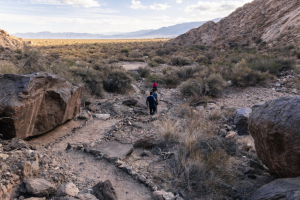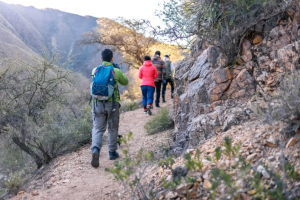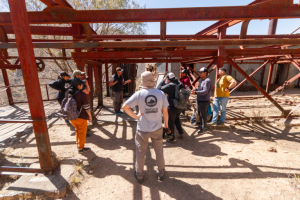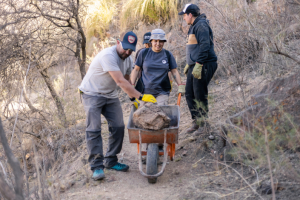Environmental education in the Sierras de Famatina: an experience of conservation and connection
In the heart of the Famatina Sierras, together with Natura Argentina and the municipalities of Chilecito and General Lamadrid, we conducted a survey of trails in search of answers: is it necessary to open new trails to get to know the mountain?
Thus, we traveled 92 km along 17 traditional trails used for recreation and sports, valuing their role in conservation and connecting people with nature. These routes provide access to unique landscapes, sites where there is a great biocultural diversity, the trails lead us to essential territories for environmental education and awareness.
To enrich the experience, we invited educator Cynthia Dabul and park ranger Joaquín Piedrabuena from Proyecto Ambiental Escuela, who coordinated participatory workshops with more than 70 people from the tourism sector. Participants created interpretive narratives for the trails, focusing on water, fauna, medicinal plants, and local history, which will be translated into interpretive signage.
In addition, national park rangers Lucas Fonzo and Javier Lucotti led practical workshops on trail design and maintenance, strengthening local capacities to preserve these trails as conservation tools.
In this article we would like to invite you to retrace that journey, to discover the magic and power of mountain trails, and how they can change people’s lives, leading them to discover nature.
Spaces of discovery: how trails can become a territory for environmental education
In addition to their practical function, trails are spaces where people have the opportunity to connect with nature, to walk through it and to discover it. They allow locals and tourists to learn about the importance of conserving regional ecosystems, promoting outdoor recreational activities. The trails have the potential to become tools for environmental education and awareness-raising about the places they invite visitors to explore.

In addition to their practical function, trails are spaces where people have the opportunity to connect with nature.
But trails are also fragile: they are bare soil, a kind of scar on the skin of the landscape, so it is important that they are sustainable. Without proper design and maintenance, they can become a problem for the conservation of soil, vegetation and the natural ecosystem.
In the heart of the Sierras de Famatina, La Rioja, Natura Argentina, together with the municipalities of Chilecito and Gral. Lamadrid, has had an experience that teaches us some ideas about the effectiveness of proposals to revalue these spaces and make them available for conservation.
To begin this task, we asked ourselves: is it necessary to open new trails to get to know the mountains?

We hiked miles of mountain to understand the trails, their possibilities and threats, from their traces.
That concern mobilized us to survey 17 trails, paths and trails throughout the length and breadth of the Sierras de Famatina, covering more than 92 kilometers from June to December 2023. Many of these areas are traditionally used for recreation, sports, and other activities.
The trails offer access to unique places, cultural and natural heritage, incredible views, and unforgettable experiences.
The surveys allowed us to make informed decisions to collaborate with the municipalities in the maintenance and readjustment of some of these places, accompanying them with environmental education and heritage interpretation tools.

The trails lead to territories full of imaginary of the past, present and future of the mountain.
One trail, many stories…
Cynthia Dabul and park ranger Joaquín Piedrabuena, from Proyecto Ambiental Escuela, an environmental education school and consulting team specialized in connecting people with nature as a strategy for social transformation.
Together with them, we organized face-to-face workshops in both locations, where more than 70 people linked to tourism participated. The purpose was to share heritage interpretation tools, so that participants could learn techniques that would enrich the experience of visitors, helping them to create a meaningful connection with the environment.
During the workshops, Cynthia and Joaquín proposed to the participants to create their own narratives for the trails, recognizing that the same trail can convey multiple messages depending on each person’s perspective. Thus, each group developed four different interpretation proposals, highlighting themes such as water, fauna, medicinal plants and the stories of the ancient settlers.
Based on these collective narratives, interpretive signage will be designed and placed on the trails, showing visitors the vision and values of the local communities.
Why do we work in participatory workshops?

From theory to practice, we move on to action. Working on the trails, we make the path as we go.
Building a trail and maintaining it is a craft, and we want every activity we undertake to be an instance of capacity building. That is why we invited guides, students and municipal staff to train them in the design, construction and maintenance of trails. This activity was led by national park rangers Lucas Fonzo and Javier Lucotti, who shared their vast experience in the management of trails in protected areas and nature trails. The trail worked on was the one that leads to Station 3 “El Parrón” of the Cable Carril, which starts from Don Abraham’s post.
In this way, the theoretical knowledge was put into practice, so that the participants can apply it in other areas. It is essential that the trails are maintained regularly to ensure that they fulfill their role in conservation, and in turn provide the best possible experience to those who walk them.

Environmental education proposes us to approach the trails from the involvement, respect and enjoyment of nature.
Maintenance teams, tourist and mountain guides, students and people interested in contributing to the care and sustainability of the Sierras de Famatina were able to reflect on the importance of caring for these spaces, not only for the enjoyment of visitors, but also for the preservation of local ecosystems. Knowing that each person who walks the trails is an opportunity to sow the seed of respect and conservation, ensuring that the small treasures hidden on the trail will last for generations.
●

Natura Argentina Team
Natura Argentina is dedicated to conserving rainforests and habitat in Latin America through bottom-up efforts led by local initiatives.




